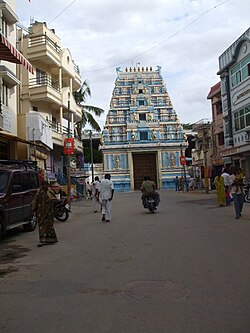Shanti (Sanskrit)
The term Shanti ( Sanskrit ś śāntiḥ ) means absolute inner peace .
etymology
The Sanskrit word शान्तिः (śāntiḥ), in English Shanti or Shantih, is derived from the adjective शम - śama - with the meaning calm, quiet and implies contentment, calm, tranquility, fulfillment and ultimately bliss.
definition
The feminine noun shanti can be translated as follows: calmness of the mind, peace of mind, inner peace, peace, salvation, blessing, well-being, going out (of the fire), slackening, cessation, pause, interruption, lack of an evil effect, the entrance to eternal Rest, dying and death .
Shanti can be defined as a state of mind that is characterized by absolute inner peace, calm imperturbability and the absence of frenetic thoughts sent by the mind. This incessant intellectual activity is called Vritti in Sanskrit . When the state of shanti is reached, extreme equanimity, equilibrium, centeredness and moderation arise. Thanks to it, the individual is able to live completely focused and serene at any given time.
characterization

In Hinduism
Shanti is an often used and highly valued term in Hinduism that occurs in all of its different currents. This concept is mentioned in numerous Hindu scriptures, including the Vedas , the Upanishads and the Bhagavad Gita . The achievement of inner peace, which proceeds from the actual presence or an identification with the divine (in its personal aspect as Ishvara or impersonally as Brahman ), is the goal of all philosophical directions and schools of thought of Hinduism. Here are a few examples:
- In Bhakti Yoga (for example in the Hare Krishna movement ) Shanti is established through devotional worship through which a positional relationship to the personified God is restored.
- According to the non-dualistic Advaita Vedanta , any form of duality arises from suffering. Shanti, on the other hand, is a direct result of liberation from all causes that arouse suffering; it is also the ability to distinguish between true and untrue and is based on non-identification with all facets of the dual world of appearances. Only shanti makes it possible to recognize the Atman in one's own self.
- In the Bhagavad Gita, Krishna Shanti declares the ultimate goal of all yogas :
"युञ्जन्नेवं सदात्मानं योगी नियतमानसः
शान्तिं निर्वाणपरमां मत्संस्थामधिगच्छति"
"Yuñjann evaṁ sadātmānaṁ yogī niyata-mānasaḥ
śāntiṁ nirvāṇa-paramāṁ mat-saṁsthām adhigacchati"
"By constantly practicing in this way to control body, mind and activities, the mystical transcendentalist attains peace, ends his material existence and comes to Me"
In Buddhism
Tenzin Gyatso , the current 14th Dalai Lama , emphasizes the importance of Shanti for world peace:
“The question of an actual, lasting world peace affects all of humanity. It has its roots in basic, typically human feelings. By attaining inner peace, world peace can ultimately also be targeted. The central importance of individual responsibility is therefore obvious. First, a peaceful atmosphere must be realized within ourselves, which can then spread to our families, our communities, and ultimately to the entire planet. "
As a mantra
Shanti was first used as a mantra in the Upanishads , mostly as an introduction and at the end of a verse. For example, the invocation in the Isha-Upanishad ends with three repetitions of Shanti:
“ Oṁ pūrṇam adaḥ pūrṇam idaṁ
pūrṇāt pūrṇam udacyate
pūrṇasya pūrṇam ādāya
pūrṇam evāvaśiṣyate
oṁ shanti shanti shanti "
" Oṁ. The personality of God is perfect and perfect. Since she is perfectly perfect, all of her emanations, like this phenomenal world, have also been perfectly created as a whole. Whatever is separated from the complete whole is in itself complete. Since the personality of God is a whole, it remains in perfect balance even after all these complete parts are separated . Oṁ. Peace, peace, peace. "
Modern use
The term shanti has recently experienced a revival thanks to very popular thinkers such as Mahatma Gandhi or Sathya Sai Baba , who use it in their writings (for example in Gandhi's philosophical concept of Satyagraha ). Shanti also has a central position in modern yoga movement.
In his lyrical poem Das wüsten Land (The Waste Land), TS Eliot uses the mantra based on the Upanishads:
"Datta. Dayadhvam. Damyata.
Shantih shantih shantih "
As a proper name
Like so many other expressions in Hinduism, shanti has found its way into proper names. In Indian mythology , Shanti was the daughter of Shraddha and Daksha . Shanti were also called the women of Dharma and Atharvan . Shanti is also a name of Durga . One of the 50 Shaktis of Ganesha was also named Shanti.
See also
Individual evidence
- ↑ Search results "SAnti". In: spokensanskrit.org . Retrieved April 29, 2020 .
- ^ BM Sullivan: The A to Z of Hinduism . Vision Books, ISBN 81-7094-521-6 , pp. 197 .
- ↑ Śrī Śrīmad AC Bhaktivedanta Swami Prabhupāda : Bhagavad-gītā as it is . The Bhaktivedanta Book Trust International, 1987, ISBN 91-7149-401-4 .
- ↑ Kraft, Kenneth: Inner Peace, World Peace: Essays on Buddhism and Nonviolence . 1992, p. 2 .
